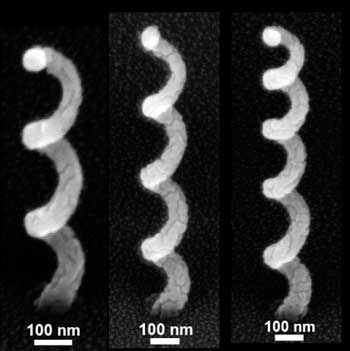| Aug 23, 2019 | |
Save time using maths: Analytical tool designs corkscrew-shaped nano-antennae(Nanowerk News) The nanostructures from Katja Höflich's HZB team are shaped like corkscrews and made of silver. Mathematically, such a nano antenna can be regarded as an one-dimensional line that forms a helix, characterized by parameters such as diameter, length, number of turns per unit length, and handedness. |
|
| The nano corkscrews are highly sensitive to light: depending on frequency and polarisation, they can strongly enhance it. Because helical antennas have a handedness, they can select light quanta according to their handedness, i.e. their spin. This results in novel applications in information technology based on the spin quantum number of light. Another application may lay in sensor technology in detecting chiral molecular species down to the single molecule level. | |
 |
|
| The nano-antennae were produced in an electron microscope by direct electron-beam writing. (Image: HZB) | |
| Usually, the interaction of such nano-antennas with an electromagnetic field is determined using numerical methods. Each helix geometry, however, requires a new numerically expensive calculation. | |
| For the first time, Höflich and her team have now derived an analytically exact solution of the problem (Optica, "Resonant behavior of a single plasmonic helix"). | |
| "We now have a formula that tells us how a nano-antenna with specific parameters responds to light", says Höflich. This analytical description can be used as a design tool, as it specifies the required geometrical parameters of a nano-helix to amplify electromagnetic fields of desired frequencies or polarisation. | |
| The HZB researchers were able to fabricate nano-antennae in an electron microscope by using direct electron-beam writing. The electron beam first writes a helix-shaped carbon structure one point at a time. This structure is subsequently coated with silver. The actual measurements of the optical properties for these silver nano-antennae are in good agreement with the calculated properties predicted by the analytical model. |
| Source: Helmholtz-Zentrum Berlin für Materialien und Energie | |
|
Subscribe to a free copy of one of our daily Nanowerk Newsletter Email Digests with a compilation of all of the day's news. |
